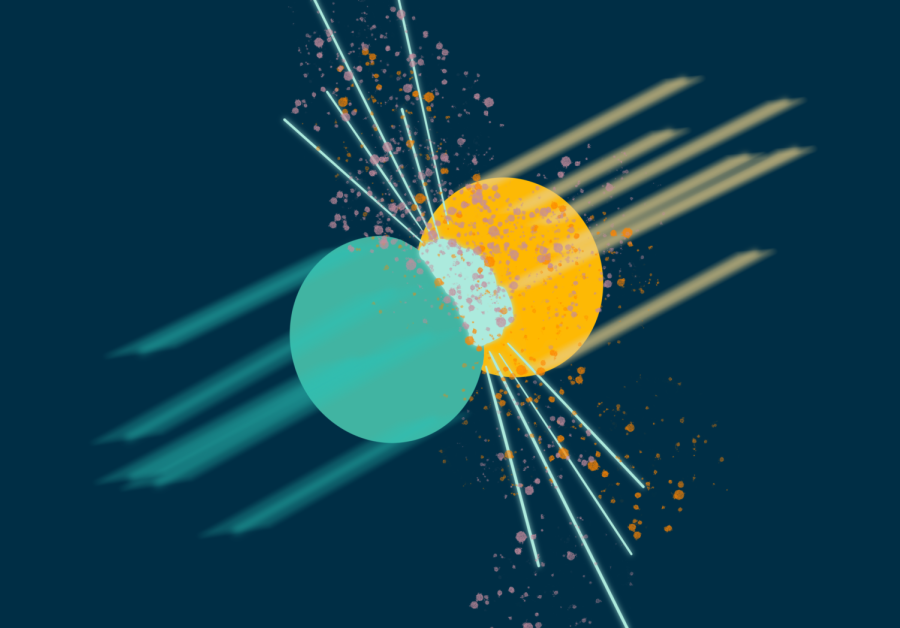The Lawrence Livermore National Laboratory reported the first net gain in energy production from a nuclear fusion reaction last month, meaning this long-pursued energy source could reach utilization in the medium-term future. In a time when plentiful fuel availability and minimal carbon emissions are both top priorities, nuclear fusion supplies an opportunity, if our engineers and public leaders are up for the task.
Back in October, I wrote about current nuclear fission energy sources in consultation with Todd Allen, professor and chair of the nuclear engineering and radiological sciences department at the University of Michigan. I spoke with him again, this time about nuclear fusion.
Nuclear fission and fusion may sound similar, but they can be thought of as opposites. As Allen explained, fission happens when a heavy atom is split apart, generating a lot of energy. Fusion, on the other hand, involves forcing two very light atoms together, which can generate a tremendous amount of energy, he said.
The trouble with forcing two very light atoms, such as hydrogen, together is they tend to repel each other like two magnets of the same charge. “The only way to get them to join is to get them going tremendously fast,” Allen explained.
There are two ways to get the atoms going fast enough to fuse: by getting the atoms very, very hot, or by compressing them together. He said getting the atoms very hot and trying to contain them with magnets has proved difficult. However, the way that the Livermore National Lab achieved it was different.
“They essentially compressed a little target with 192 different lasers around it, all pointing at it. And they’ve got to get all those lasers to fire at the exact same time. So you compress uniformly,” he said.
Allen noted this is not the first time physicists have achieved nuclear fusion, but in the past, it has always taken more energy to get the atoms to fuse than the fusion itself produced. This news is a great step forward, but Allen cautioned that the use of nuclear fusion energy in businesses and homes is still a ways off.
For a new source of energy to be viable in the energy market and helpful for us in reaching for energy independence and flexibility, it needs to be safe, deliverable and readily available. We have seen what happens when these important parameters break down.
Safe, clean, abundant energy
In terms of safety for both people and the environment, nuclear fusion is a lot safer than one might expect.
Allen explained that nuclear fusion is inherently safer than nuclear fission, and it is also a zero-carbon energy source. He said because nuclear fusion requires very precise conditions to happen, it is a very easy reaction to stop. That, paired with the fact that the fuel that goes into nuclear fusion — hydrogen or helium atoms — are very safe sources shows nuclear fusion has an inherent level of safety that few energy sources can boast about.
Allen also said radiation containment would likely not be much of an issue. Because the reaction can be stopped easily and the original fuel sources are safe, “there’s not a thing like a runaway fusion,” Allen said. Any radiation produced by nuclear fusion plants in the future, Allen said, could be dealt with using existing radiation safety measures.
“Radiation safety programs deal with this and it’s very simple,” he said.
The fuel required for nuclear fusion is also readily available. Hydrogen and helium atoms would likely be the primary fuel sources for nuclear fusion energy production, as they are the two lightest atoms in existence.
Hydrogen is the most abundant element on Earth (there are two hydrogen atoms in every molecule of water), and helium can be produced through nuclear fusion of hydrogen. The sun, which is mostly made up of hydrogen gas, uses nuclear fusion to produce energy, light and helium gas.
Considering that nuclear fusion of hydrogen produces helium — another possible fuel — it is possible that some of the byproducts of nuclear fusion energy could be recycled. However, as the atoms produced get heavier, the fusion process becomes more difficult because larger atoms have higher amounts of resistance to fusion.
Some engineering required
Allen cautioned that the biggest barrier to delivery of nuclear fusion energy to the market is likely the engineering it will take to make the process more efficient, and make it possible to capture the energy and transport it to destinations that need it.
“First, you’ve got to figure out how to just repeat it,” Allen said of the current state of nuclear fusion work. The news out of the Livermore National Lab is excellent, but this process needs to be repeatable before we get too excited about seeing nuclear fusion as a source of household energy.
“The second thing is, even though you measure that the energy released was more than you put in front of lasers, you have to figure out a way to capture that in a way that you could turn it into useful energy,” Allen said. He noted that, due to some funding limitations and how long it has taken to get to this stage, not enough progress has been made for strategies to increase efficiency and containment of the energy output for use down the line.
Allen said that practically speaking, it could be 10 years or more until we see nuclear fusion energy hit the market. He noted there are privately funded fusion companies that claim to be working on the issue, so it could be sooner, but it is hard to say because these companies have been pretty tight-lipped about their developments.
At the end of the day, the key to moving forward with nuclear fusion energy to the point of welcoming it into widespread use will be to bring the public into the fold, Allen said.
“Whether it’s nuclear fission or fusion, it’s bringing people in, showing them how this works, making it visible,” he said.
Would you like Allison to follow up on this topic or explore something specific? Contact her at [email protected] with questions, comments or story ideas.






















